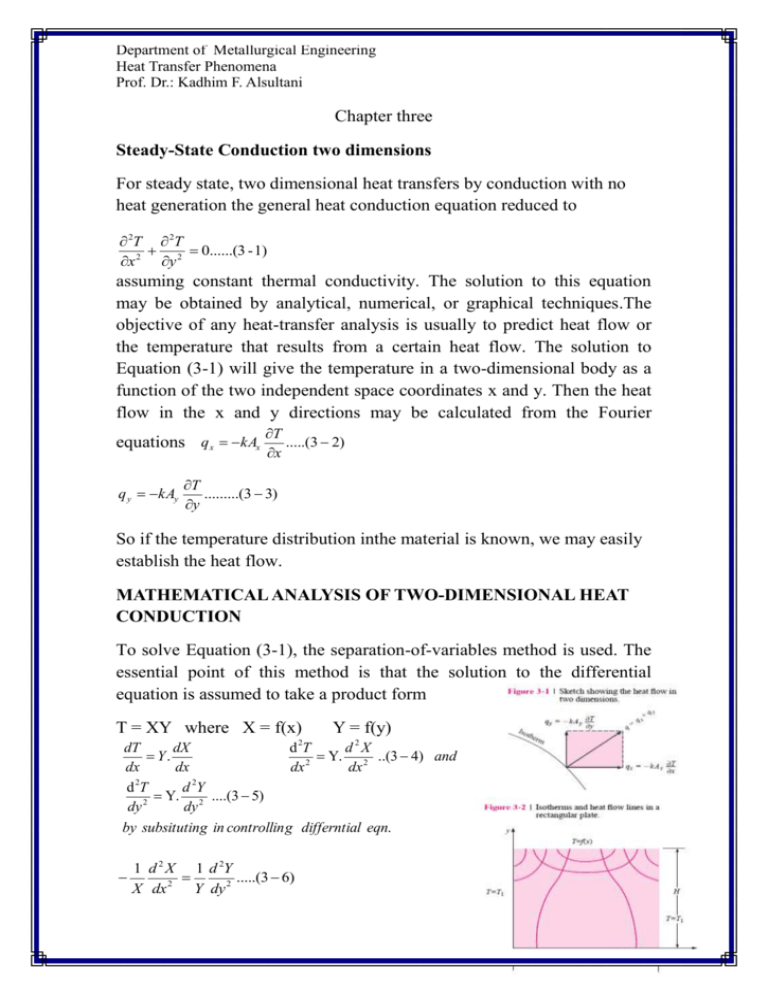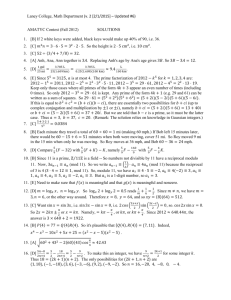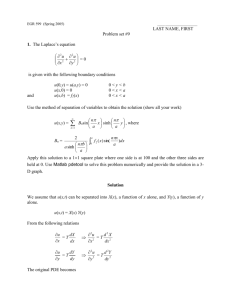Steady-State Conduction two dimensions
advertisement

Department of Metallurgical Engineering Heat Transfer Phenomena Prof. Dr.: Kadhim F. Alsultani Chapter three Steady-State Conduction two dimensions For steady state, two dimensional heat transfers by conduction with no heat generation the general heat conduction equation reduced to 2T 2T 0......(3 - 1) x 2 y 2 assuming constant thermal conductivity. The solution to this equation may be obtained by analytical, numerical, or graphical techniques.The objective of any heat-transfer analysis is usually to predict heat flow or the temperature that results from a certain heat flow. The solution to Equation (3-1) will give the temperature in a two-dimensional body as a function of the two independent space coordinates x and y. Then the heat flow in the x and y directions may be calculated from the Fourier equations q x kAx q y kAy T .....(3 2) x T .........(3 3) y So if the temperature distribution inthe material is known, we may easily establish the heat flow. MATHEMATICAL ANALYSIS OF TWO-DIMENSIONAL HEAT CONDUCTION To solve Equation (3-1), the separation-of-variables method is used. The essential point of this method is that the solution to the differential equation is assumed to take a product form T = XY where X = f(x) 2 Y = f(y) dT dX dT d2X Y. Y. 2 ..(3 4) and dx dx dx 2 dx 2 2 dT d Y Y. 2 ....(3 5) 2 dy dy by subsituting in controllin g differntial eqn. 1 d 2 X 1 d 2Y .....(3 6) X dx 2 Y dy 2 Department of Metallurgical Engineering Heat Transfer Phenomena Prof. Dr.: Kadhim F. Alsultani Each side of Equation (3-6) is independent of the other because x and y are independent variables. This requires that each side be equal to some constant. We may thus obtain two ordinary differential equations in terms of this constant . 1 d 2 X 1 d 2Y 2 2 2 X dx Y dy This equation gives two differential equations d2X 2 X 0 …(3-7) 2 dx d 2Y 2Y 0 ….(3-8) 2 dy Where λ2is called the separation constant. Its value must be determined from the boundary conditions. Consider a rectangular plate shown in figure ,three sides of plate maintained at constant temperature (T1). The boundary conditions with a sine-wave temperature distribution impressed on the upper edge of the plate. Thus (1)T=T1 at y = 0 (2)T = T1 at x = 0 (3)T=T1 at x = W (4) Tm Tm sin x W at y = H Where (Tm) is the amplitude of the sine function. The first step in solving the problem is examine the value of (λ2),there are three possibilities (λ2=0, λ2<0,and λ2 >0) one of this value is acceptable ,and the other will be neglected. For λ =0 2 d2X 0 dx 2 The solutions are X=(C1+C2x) Y=(C3+C4y) and d 2Y and 0 dy 2 Department of Metallurgical Engineering Heat Transfer Phenomena Prof. Dr.: Kadhim F. Alsultani T= (C1+C2x) *(C3+C4y)…(3-9) This function cannot fit the sine-function 2 boundary condition, so theλ =0 solution may be excluded X (C5e x C6 e x ) For 2 < 0 Y (C7 cos y C8 sin y ) T (C5e x C6 e x )(C7 cos y C8 sin y ) .....(3 - 10) Again, the sine-function boundary condition cannot be satisfied, so this solution is excluded also. X (C9 cos x C10 sin x) For > 0 Y (C11e y C12e y ) 2 T (C9 cos x C10 sin x)(C11e y C12e y )....(3 11) Now, it is possible to satisfy the sine-function boundary condition; so we shall attempt to satisfy the other conditions. The algebra is somewhat easier to handle when the substitution is made as T T1 The transform of the boundary conditions are (1)θ = 0 (3)θ = 0 at y = 0 (2)θ = 0 at x = W (4)θ = Tm sin Applying these conditions, we have 0 (C9 cos x C10 sin x)(C11 C12 )...[ a] 0 C9 (C11e y C12e y ).....[b] 0 (C9 cos W C10 sin W )(C11e y C12e y )....[c] Tm sin x W (C9 cos x C10 sin x)(C11e H C12e H )...[ d ] Accordingly C11=-C12 and From [c] 0 C10 C12 sin W (e y e y ) This requires that SinλW = 0 …..(3-13) n W ……(3-14) C9=0 at x = 0 x W at y = H ..(3-12) Department of Metallurgical Engineering Heat Transfer Phenomena Prof. Dr.: Kadhim F. Alsultani where n is an integer. The solution to the differential equation may thus be written as a sum of the solutions for each value of n. This is an infinite sum, so that the final solution is the infinite series. T T1 Cn sin n 1 nx ny sinh .....(3 15) W W Where the constants have been combined and the exponential terms converted to the hyperbolic function. The final boundary condition may now be applied: Tm sin x W Cn sin n 1 nx nH sinh W W which requires that Cn = 0 for n > 1. The final solution is therefore T Tm sinh( y / W ) x sin( ) T1......(3 16) sinh( H / W ) W Department of Metallurgical Engineering Heat Transfer Phenomena Prof. Dr.: Kadhim F. Alsultani Graphical analysis Consider the two-dimensional system shown in Figure. The inside surface is maintained at some temperatureT1, and the outer surface is maintained atT2. To calculate the heat transfer, isotherms and heat-flow lanes have been sketched to aid in these calculation .The isotherms and heat-flow lanes form groupings of curvilinear figures like that shown inFigure. The heat flow across this curvilinear section is given by Fourier’s law, assuming unit depth of material. if [Δx=Δy], the heat flow is proportional to the ΔT across the element and, since this heat flow is constant, the ΔT across each element must be the same within the same heat-flow lane. Thus the ΔT across an element is given by Where N is the number of temperature increments between the inner and outer surfaces. Where M is the number of heat-flow lanes. the number of temperature increments between the inner and outer surfaces is a bout N=4, while the number of heat flow lanes for the corner section may be estimated as M=8.2. The total number of heat-flow lanes is four times this value, or 4×8.2=32.8. The ratio [M/N] is thus 32.8/4=8.2 for the whole wall section.









